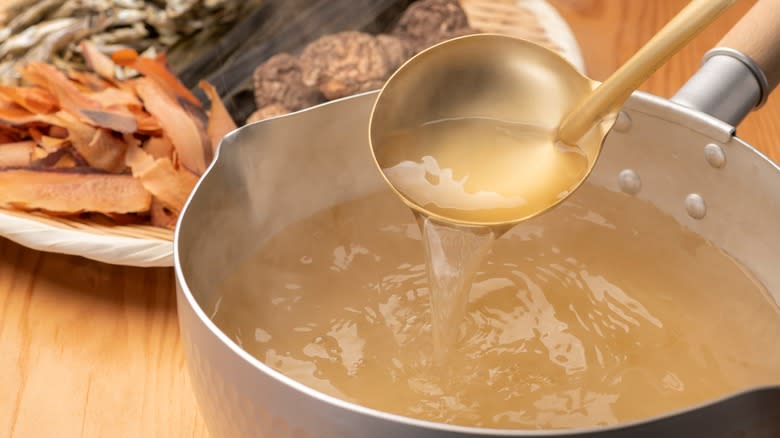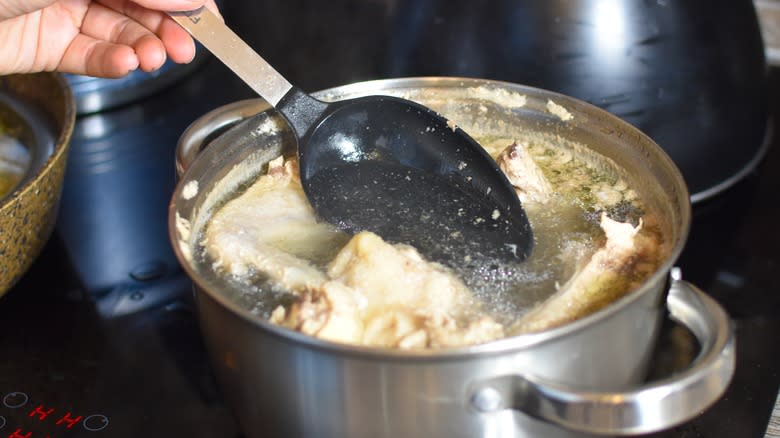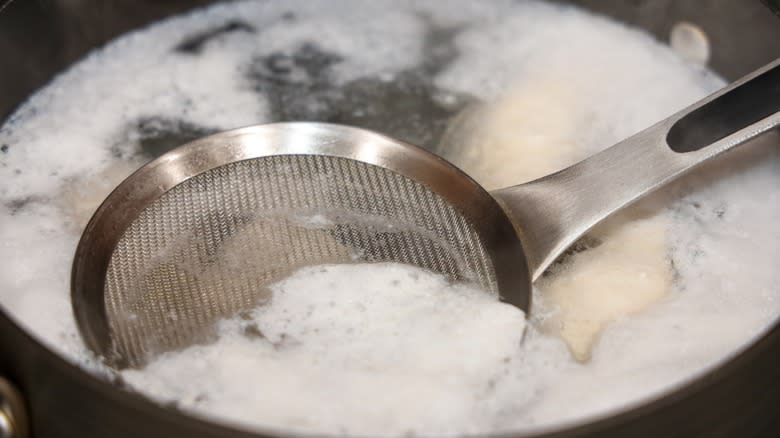The One Extra Step You Need For Dramatically Improved Soup

Picture this: your largest stockpot is filled with a delicious broth and hearty, tasty ingredients simmering away on the stove. But as time goes on and you leave your soup or stock to simmer, you start to notice a filmy layer rising to the top, coagulating into a bubbling, grayish layer at the surface. It's certainly off-putting, but does soup scum actually affect your soup?
While the taste of your soup or stock may not be dramatically altered, not skimming your soup early enough could result in some unappealing changes to your final product. Not only will the grayish scum leave an undesirable change in the broth's appearance, but your soup's texture could be affected, as well. It's not unsafe to consume but left unskimmed, the layer of scum can give your precious broth a cloudy mouthfeel. Skimming your soup is one of those elements that isn't necessary, but can take your soup from suitable to spectacular.
Read more: 12 Discontinued Store-Bought Soups We Aren't Getting Back
What Is The Scum That Floats To The Top Of Your Soup?

So if the foamy scum is safe to eat but still negatively affects your soup's appearance and texture, what exactly is it? You'll most often see this layer begin to form as you boil stocks or soups containing ingredients with high amounts of protein. Think chicken bones, meat proteins, or even legumes like chickpeas. These bits of protein cook off and start clumping together at the surface of your soup.
Vegetable broths are unlikely to produce much scum, but if you're making a hearty protein-packed bone broth, the broth will develop lots of it. It all depends on your soup goals. If your aim is a clear broth, skim off the top layer. If you want the protein bits in your soup and don't mind the change in appearance or texture, you can leave it. But in most cases, soup scum is simply unappetizing to look at and can mess up your homemade chicken broth.
Tips For A Successful Soup Skimming

If you want to make sure you successfully skim the scum from your soup, it's important to have patience. One water-boiling trick to avoid scum is to slowly simmer your soup instead of hitting it with high heat right away. This encourages a slow cooking of all your ingredients, and the coagulated proteins will only appear once the broth or stock grows to a boil. Once you see the bubbly layer start to form, turn the heat even lower to keep the broth at a simmer so you can more easily skim the top of the soup. If you leave the stock to boil for too long, the scum will start incorporating back into the soup, giving the entire pot that unwanted cloudy texture and appearance.
Luckily, there's a kitchen tool made exactly for the job: A fine-mesh skimmer. While there are other items to help skim fat from liquids, a fine-mesh skimmer will have a long handle like a ladle, but a flat, round attachment made of fine mesh to gently skim off the scum while leaving your hard-earned flavorful broth behind. So if your goal is a clear soup stock, then make sure you take the time to skim off the impurities. Then you can slurp away at your soup scum-free!
Read the original article on Daily Meal

